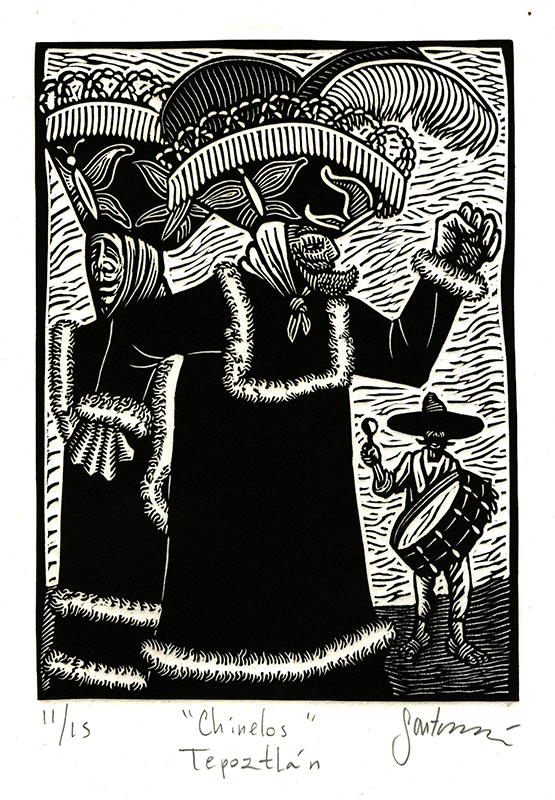Chinelos Tepoztlán is a linocut from 2016 by Mexican artist Sergio Sánchez Santamaría. It is from the series Pesonajes de Morelos, Mexico and is pencil signed, titled and editioned 11/15. Chinelos Tepoztlán is printed on white wove paper and was published by Grafica Del Grabador Sergio Sánchez Santamaria. The image measures 11-3/4 x 8-5/8 inches.
Two costumed figures dance to the drumbeat during Carnival in Tepoztlán, Morelos, Mexico. The performers are referred to as Chinelos based upon the homemade Chinelo which consists of an elegant velvet tunic, usually black, red, or dark green, trimmed with lace or rabbit fur. Their conical hats have hand-embroidered decorations with sequins, beads, flowers, or animals that represent the neighborhood of Tepoztlán. The hat is further embellished with strings of plastic pearls that hang around the brim and topped by ostrich feathers. A bandana is used to cover the head and white gloves are worn. The Chinelos wear masks with pointed beards and clear eyes which reflect the origin of the dance which makes fun of the Spanish landowners who forbid the Mexican population from participating in their parties before Holy Week. These masks are made of wire cloth, painted mostly white with red cheeks, and the stiff, upturned beard is beef hair.
Sergio Sánchez Santamaría, painter, muralist, printmaker, scratchboard artist, and teacher, was born in Tlayacapan, Morelos, Mexico on 8 July 1976 and grew up in Tacubaya, which is part of Mexico City. He received his Bachelor of Plastic Arts degree from the Escuela Nacional de Pintura, Escultura, y Grabado, a.k.a. La Esmeralda, in Mexico City. He was a student of Adolfo Mexiac, Alberto Beltrán, Jesus Ávarez Amaya, and Leo Acosta.
Regarding his career in printmaking, he stated: “I began the profession of engraving in 1997 at the Taller de Grafica Popular, because of my curiosity to learn to engrave and my admiration for masters such as Barry Moser, Leopoldo Méndez, MC Escher, Lyn Ward, Kathe Kollwitz or Franz Masserel. In the TGP, Professor Alfredo Mereles was my first teacher and he was the one who recommended the use of Speedball gouges and handles. He told me that they were more practical and of very good quality. I love the sharpness of the knives, plus they last a long time, as well as the comfort of their handles. You can even store the knives inside the handles, so you don't lose them.”
In a 2020 interview with Nick Rowan, Santamariá proclaimed: “I’m an artist, and the core of my art is scratchboard drawing. As a profession, I’ve developed my skills in printmaking and other techniques. Although my specialty is lithography, I also work with wood, linoleum, dry point, etchings, aquatint, burin, soft varnish, mezzotint, etc.”
Sánchez Santamaría has exhibited his work throughout Latin America and Europe, in the United States, and in Japan and China. He describes his art “as contemporary, with a retro and a futuristic tendency. My art is eclectic and humanistic. Humanistic because I am interested in society and in the individual.”
There have been three books published on his life and work including: Los Viernes de Cuaresma en Morelos, 2016; Sergio Sánchez Santamaría: Dos Decadas de Grafica, 2017; and Graphic in Transit: Sergio Sánchez Santamaría, 2021.
Sergio Sánchez Santamaría is represented in numerous special collections including, but not limited to, the Bancroft Library, University of California Berkeley; Duke University Libraries, Durham, North Carolina; Rare Books and Special Collections, University of Notre Dame, Indiana; and Special Collections, Firestone Library, Princeton University, New Jersey.



